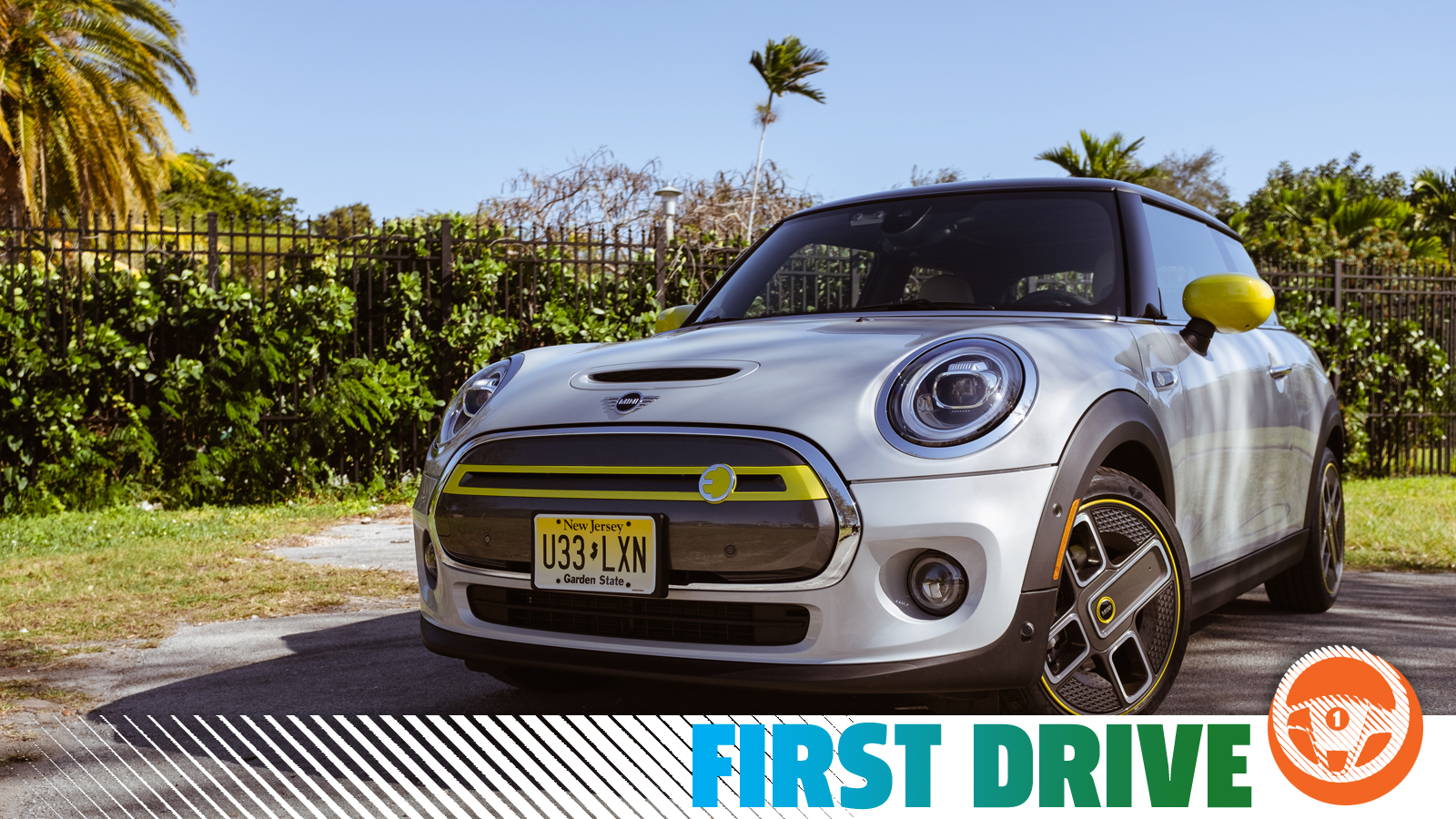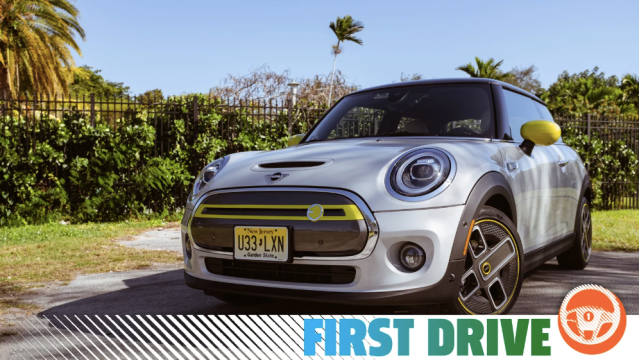The 2020 Mini SE is a hack-job electric car with parts from the BMW i3 that somehow only gets an estimated 110 miles of range on a charge. It feels about five years late, but it’s also relatively cheap, well-equipped and a ton of fun to drive still.
(Full Disclosure: Mini was kind enough to cover airfare, lodging, and food for me to visit Miami, Florida for a night to drive the new Mini Cooper SE.)
Modern Mini has always been in a tough spot with enthusiasts. The cars have to be big for safety regulations, so everyone makes fun of them for failing to live up to their name. The cars also have to live in a crossover-dominated world, which makes them bigger, which makes the number one complaint about size that much more of an issue.
Then there are the normal car problems of keeping a product relevant and stylish, but unique. And on top of all of that, Mini has to work with how parent-company BMW budgets it. Sometimes that means Mini engineers don’t have to worry much about engines. Other times it involves cramming BMW parts into a platform never meant for them.
And no Mini model represents all of these challenges better than the new electric 2020 Mini SE. A hodgepodge BEV hatchback squeezed into a rapidly-dated platform and body style. It’s easy to convince yourself the SE would be a bad car. After a day of driving, though, it’s clear to me just how good the worst Mini on sale can be.
What Is it?
The 2020 Mini SE is BMW and Mini’s second attempt at an electric hatchback under the British brand. Back in 2009, the two companies basically did exactly what they’ve done again now, in 2020.
The old Mini E was based on the Mini two-door hardtop with an electric motor up front replacing the traditional gas engine. It only had an EPA estimated range of 100 miles (160km) and lost its back seat for the 35 kWh battery pack.
It was sold as a limited leasing trial program for BMW to better prepare its upcoming i-range of electric vehicles, including the BMW i3 and BMW i8. Customers leased the car for a year in the New York and Los Angeles areas, and provided feedback to the automaker. Then the cars went back to the company; some to museums, some were crushed, some were used for further testing.
The connection to the BMW i-range of plug-in vehicles has now come full circle. The 2020 Mini SE is again based on the two-door hardtop, with an electric motor now sourced from the BMW i3 an electric Mini once inspired, again replacing the traditional gas engine. But this time it keeps its back seats, as the batteries have been wedged in a T-shaped formation under the car, with the car raised a bit to improve ground clearance.
Specs That Matter
The Mini SE is front-wheel drive, claiming 181 horsepower and 199 lb-ft of torque. Its usual four-cylinder engine has been replaced with a massive brace of wires, computers, and cooling and HVAC components, and BMW’s lithium-ion battery technology has been shaped into a unique T-formation to squeeze under the existing Mini Cooper architecture. You can actually see its shape from the protective panels if you look under the car:
On paper, it’s around 300 pounds (136kg) heavier than a standard Cooper S, and slightly slower from 0 to 60 mph (96 km/h) in 7.3 seconds. Range, unfortunately, has not come very far in a decade. Mini expects the 2020 SE will only get an EPA-estimated range of just 110 miles. Ten years, ten miles of improvement. That’s worthy of a yikes.
But look at the data and those 110 miles should actually be fine for a majority of America’s daily commuters. At least as a second car.
If you want to push it beyond your daily commute, you’re going to be making some stops. A trip between New York City and Washington D.C. would have you stop at least twice to charge. The SE can charge from 0 to 80 per cent in around 35 minutes from a 50 kilowatt DC fast-charge station, so that’s about an additional hour tacked onto your trip’s commute time. It seems bad spelled out, but I promise it feels much quicker in practice.
It would take around an hour and a half to charge to 100 per cent on the same fast charger, but the tradeoff wouldn’t really make it worth it on your theoretical trip. Get to 80 per cent and just keep going, as you’d probably have to stop again anyway.
At home, charging from 0 to 80 per cent using Mini’s 11-kilowatt wall box should take an estimated 2.5 hours, or 3.5 hours to 100 per cent state of charge. The weaker 7.4-kilowatt wall box is obviously slower, charging from 0 to 80 per cent in just over 3 hours, or just over 4 hours to get to 100 per cent.
Priced from $US30,750 ($45,573) (including destination and handling fees, before incentives), the Mini SE is also fairly affordable as a second car. With the full $US7,500 ($11,115) federal tax incentive, the price drops to $US23,250 ($34,457). Add any state and local incentives on top of that, and you’re quickly whittling down to a very attractive leasing offer.
But if you can get over the limited range, what else does the Mini SE offer?
What’s Good
The best part about the Mini SE, as we learned in our earlier, brief drive last year, is that it drives exactly like a Mini. Visibility is good, the additional weight over the standard car doesn’t feel like a big penalty (unless, perhaps, you were to drive the two back to back), and there’s just not a lot of car surrounding you, which makes the connection to the road just a little more prevalent.
What’s important is the SE doesn’t drive like the parts-bin special that it is. Moving the batteries from the original Mini E from the seats down into the actual structure of the car helps lower the centre of gravity, giving the car solid grounding and a sensation that you could push it maybe just a little harder than a combusting Mini two-door.
As with most EVs, the throttle is immediate, surging the car forward without your body, your back squishing into the seat and catching up with the rest of the car just a fraction slower. What’s even more impressive, though, is the acceleration while you’re already cruising. This is the complete opposite of what happens in an original Mini (pre-BMW), and yet somehow it feels perfectly suited to the car.
The SE has incredible last-minute exit-lane energy, letting you pass that Semi you hesitated to get behind, or surge ahead a few car lengths more than you might with the comparably sluggish torque of a four-cylinder in high gear.
If you’ve driven a newer BMW i3 which, as we’ve established, shares a motor and some other gear with this, you should have a very clear picture of what to expect with driving this car.
One of my main worries before driving the SE was that it would struggle with noise without the combustion engine, but the quiet nature of the electric hatch wasn’t hindered by any obtuse road or wind noise at highway speeds like I feared. The cabin is comfortably quiet.
I also liked the driver information screen behind the steering wheel, the option of two braking-regeneration settings for those who still prefer to mostly use the brake pedal traditionally (I’m a big one-pedal driving fan on EVs, personally), and there’s a noticeable improvement in the steering feel and “throttle” response in the Sport mode, one of four modes also including Mid, Green, and Green+.
Navigation is standard, as is Apple CarPlay compatibility, LED headlights, and remote services for stuff like pre-conditioning the interior, checking the status of the car’s state of charge, and locking or unlocking doors using the available phone app.
What’s Not So Good
The Mini SE is a good car all on its own, but it’s incredibly complicated to defend. And you will spend a lot of time defending it.
I’ve never been a fan of Mini’s Playskool-style interiors. To me, the childish nature of the circular centre infotainment stack, with the tacked-on bulbous speedometer and the various globs of plastic always conflicted with the leather seats and occasional BMW feature. Every time I climb in a modern Mini I feel like I’m interrupting a crisis of identity.
The SE is also slower and heavier than its gas counterpart, and isn’t available in a four-door model. It has less range than the BMW i3, the donor for the SE’s batteries and motors (though not in identical configuration). It also isn’t half as innovative or stylish as the BMW.
Its solid-nose design”a strong character trait for electric vehicles popularised by Tesla’s in-your-face grilleless design language”looks like an afterthought. And it’s all packaged in a body that’s already been around since 2014. It’s hardly the fresh start for the future of Mini it probably should be.
Early Verdict
Earlier this month, Mini’s head of communications Andreas Lampka told Australia’s Motoring that Mini isn’t a “total fan” of electric vehicles. He also talked down one of the main appealing factors of driving an electric car at our product presentation (which was only about five minutes long, a record for me), claiming he preferred to brake on his own rather than let the car’s regenerative braking slow it down for him.
It shouldn’t be surprising that a company with that outlook didn’t cut a fresh start on developing an electric model, with its own platform. So why did it bother?
I’d like to think the 2020 Mini SE will function like the 2009 Mini E”practice for a better product. BMW has previously claimed it’s only interested in a one-platform-fits-all approach to electrifying its vehicles. This means it wants one platform that can take combustion, hybrid, and fully electric models. Something it can tweak and adapt as demand for powertrain shifts over the next generation or two of its products, including Mini.
Considering a one-platform approach, I’m hoping that adapting the regular Cooper platform to fit batteries and a motor was simply research. I imagine it helped the engineering team to reverse-engineer the best way to develop a shared platform from the ground up. I’m sure they learned a lot about the commonalities and restrictions shared between each powertrain.
Hopefully that translates to something with competitive range and more inspired style in the near future. Until then, the Mini SE is an emission-free car, perfect for a vast majority of daily commutes, that’s fun to drive and costs just as much as its gasoline counterpart.
In a way, there’s nothing else like it, and it doesn’t deserve to be written off just because even the automaker that built it didn’t seem to care very much.

2020 SE
+
Same Mini dynamics with a little more punch, and at a great price.
–
Ageing design, hack-job engineering, and nothing really new.
TL;DR
If you want a cheap EV lease and aren't worried about range, this one's fun.
